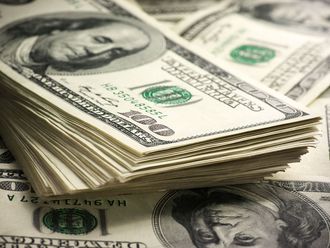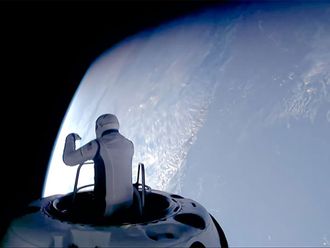Riyadh: Saudi Arabia's breakeven price for oil jumped an estimated 23 per cent after the kingdom promised the biggest public-spending increases in three decades, creating a new floor for crude as it trades near a three-year high.
More-generous benefits promised by King Abdullah Bin Abdul Aziz will cost $129 billion (Dh473 billion) over the next several years, according to John Sfakianakis, chief economist at Riyadh-based Banque Saudi Fransi. The outlays will add $15.50 a barrel to the price Opec's largest producer needs to balance its budget, according to the median estimate of analysts surveyed by Bloomberg News.
The Saudi king announced higher subsidies in February and March for housing and benefits to military and religious groups supporting his ban on protests.
The increase gives the Saudis less leeway in playing their traditional role of using spare capacity to temper prices.
"Higher spending has pushed up the breakeven prices," Jarmo Kotilaine, chief economist at National Commercial Bank in Jeddah, said in an April 6 e-mail. "Ultimately, this will be a balancing act, because they don't want to reach a point where prices begin to erode demand."
Survey result
The kingdom now needs oil to sell for at least $84 a barrel to balance its budget, according to the Bloomberg survey of six analysts. That's up from a median of $68.50 a barrel before the handouts, they estimated. The survey included Sfakianakis, Kotilaine, Shady Shaher of Standard Chartered in Dubai, Brad Bourland of Jadwa Investments in Riyadh, Leo Drollas of Centre for Global Energy Studies in London and Francisco Blanch of Bank of America Merrill Lynch in New York.
Middle East turmoil has also spurred Kuwait, the fifth-biggest producer in the Organisation of Petroleum Exporting Countries, to sweeten benefits for its population. Each Kuwaiti citizen will get 1,000 dinars (Dh13,270) and free food for 13 months, the state news agency KUNA reported on January 18. Kuwait's breakeven oil price has risen to $75 a barrel, Credit Agricole said in a report on April 6.
Opec members sold crude at $77.45 a barrel last year, according to the average price of 12 grades produced by the group. Arab Light, the Saudi grade included in the Opec basket, sold to North American customers last year at an average of $80.30 a barrel and to Asia at $78.15, according to Bloomberg data.
Brent crude, the European benchmark, has surged 29 per cent this year amid a wave of upheavals that swept two regional leaders from power. Brent was unchanged at $122 yesterday on London's ICE Futures Europe exchange. It reached $127.02 on April 11, the highest price since April 2008. West Texas Intermediate crude is up 19 per cent, trading at $107.92 on the New York Mercantile Exchange.
Those prices are well above the Saudi minimum, indicating it may achieve a budget surplus this year even with the more lavish spending, Shaher of Standard Chartered said in an April 13 interview.
"We think high oil prices are here to stay," Blanch of Merrill Lynch said on Thursday in a note. Saudi Arabia requires an oil price of $95 to cover government spending, he said.
The kingdom's room to manoeuvre declined with the price of Brent crude dropping 3.2 per cent after the International Monetary Fund said higher oil prices are endangering the economic recovery and the International Energy Agency cited signs that demand for oil may decline.
Restricted supplies
Analysts at Goldman Sachs Group forecast a "substantial pullback" on April 12 that may cut the price of Brent crude to $105 a barrel in coming months.
Saudi Arabia is "terrified" in the wake of its higher budget commitments that prices will collapse, especially if it brings too much additional oil to market, Drollas said. "They need higher prices to cover spending, and they restrict supplies to get that," he said April 12.
The kingdom cut production by 300,000 barrels in April, said Sfakianakis, who also acts as a government adviser. Saudi Arabia started reducing output this month in response to a slowdown in demand from Japan, he said. The country raised its output last month by 300,000 barrels a day to 9 million, according to a Bloomberg survey of producers, analysts and oil companies who follow output. That was about 949,000 barrels more than its target of 8.051 million.
Opec, which supplies about 40 per cent of global oil, has spare capacity of about 3.91 million barrels a day, the Paris-based International Energy Agency estimated in its monthly Oil Market Report released on April 12.
Saudi Arabia will use its excess capacity to help meet any shortage in supply or surge in demand, Oil Minister Ali Al Naimi said on April 9, according to the official Saudi Press Agency. Crude prices of $70 to $80 a barrel would be "fair" for producers and consumers alike, he said at a conference in Riyadh on February 22.
That price range is now a "moot point", given the current budget, said Greg Priddy, an analyst at Washington-based Eurasia Group, in an investor note on April 13. While Saudi policy will "seek to maintain balance in the physical oil market and prevent runaway escalation in prices," he wrote, this longer- term focus may "fuel short-term market doubts" about the government's willingness to boost output.
Saudi Oil Ministry officials couldn't be reached for additional comment.
Overspending
Saudi Arabia's breakeven level could rise as high as $106 a barrel this year if the government overspends its original budget by the same 15 per cent that it did last year, Shaher said in a research note.
The Institute of International Finance estimates the breakeven level may rise to $110 a barrel by 2015, the Washington-based banking industry trade group said in a March 30 report.
The increase in Saudi Arabia's social spending amounts to almost a quarter of the nation's econ-omic output for 2011, Sfakianakis wrote in an April 4 research note. The handouts add 45 per cent to the budget the government had forecast for the year and mark "the fastest pace of overspending in three decades", he said.











